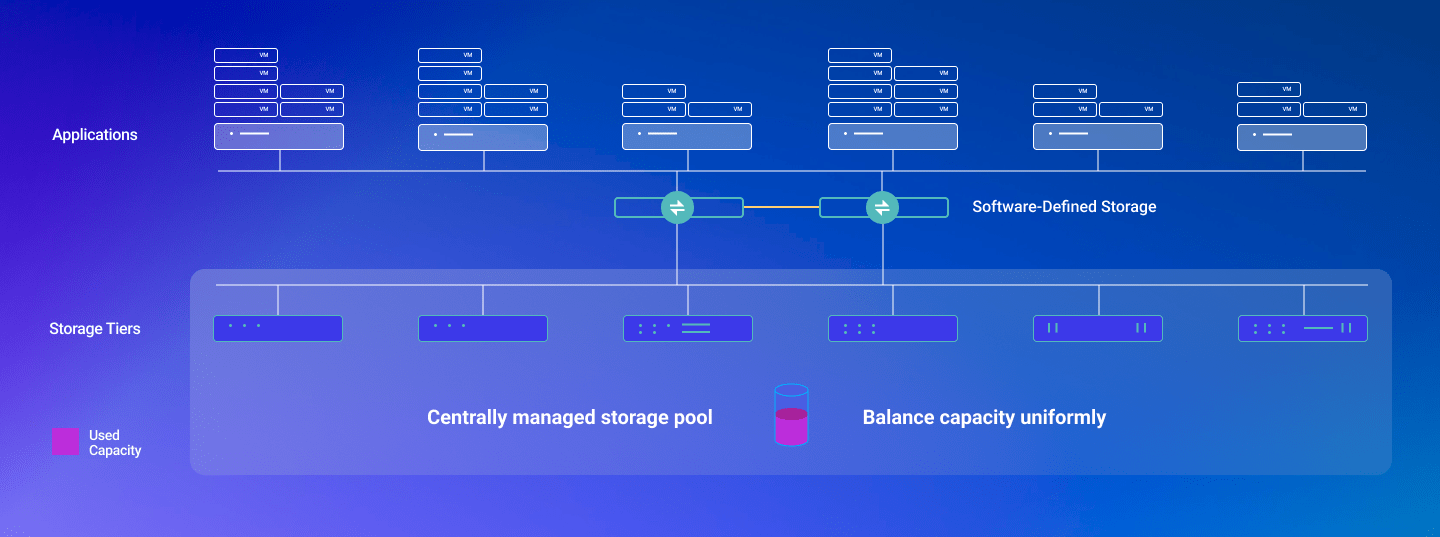
Software-Defined Storage: Specifics and Business Profit

The need for increased scalability and transparency for storage monitoring and administration often arises in business, and one of the most effective solutions, in this case, is to develop software-defined storage. In our article, we consider the definition of software-defined storage: what exactly is taken into account when developing such a solution, what technologies to use, and how you can benefit from it.
What is Software Defined Storage?
SDS (Software-defined storage) is a data storage format that allows you to store and manage data without being tied to specific hardware. Such storage usually also implies a form of virtualization that separates soft from hard. Among the actions that can be performed on data are replication, deduplication, backup, thin provisioning, and so on.
SDS and virtualization. Virtualization is the ability to run different operating systems on the same physical machine at the same time, while they use the same hardware and know about each other. On the other hand, SDS is a data warehouse that works according to its own protocols, offering the administrator to see all the servers within one interface.
Types of software-defined storage systems
Any network becomes programmable when managed in a software-defined solution format. How networks are managed determines their segmentation by type.
- Distributed File Systems: refers to multiple systems that share resources for performance and scalability.
- Containerized: managed through container orchestration.
- Based on the hypervisor: the creation, launch, and monitoring of VMs are made without interruption in work, intuitively.
- Hyper-converged infrastructure: everything is based on a successful combination of software for networking, virtualization, and computing.
How does SDS work?
To explain in more detail how SDS works and what technologies are used to create it, let’s take one of our clients, a medium-sized corporation that provides data storage and backup solutions, headquartered in San Jose, California. In this case, the basic SDS was made on the client side, and our team made a module for integration into the system. The customer approached us with the task of making an analog/adapter of the AWS S3 API for their system so that clients written to work with AWS could use their system as a data storage backend.
C++, Node.js, and Go were chosen as the languages for writing, the choice was based on the customer’s preferences. Since the system itself was quite complex and unfamiliar, a lot of time was spent understanding how the entire custom system of the customer works, how the system they wanted to imitate works, and how it could be implemented. The project took several months to complete.
Alex Suykov, Sirin Software developer:
The complexity of SDS projects in general lies in working with large amounts of data. All this is somewhere between no-SQL databases and file systems. However, it’s an interesting challenge, and being able to work with a filesystem that has no UI at all; essentially you’re dealing with a pure backend that’s farthest away from the users.
Things to consider before integrating SDS
SDS allows you to use standard x86 servers as a high-performance storage option with a high level of availability. Among these points:
- servers that can work for at least five years, taking into account guarantees,
- considering disk type, RAID, SAN design, and failover,
- it is necessary to carry out full documentation of processes,
- add redundancy at all device levels.
Software-defined storage pros and cons
As already described above, SDS has a fairly wide field of application. Although the technology was originally created for large companies with huge data flows, you can adapt the technology to your needs. Consider the main advantages and disadvantages of the technology.
Pros:
- the solution is quite economical;
- no vendor lock-in, giving flexibility in switching between software-defined storage solutions;
- even incompatible devices can be used to host storage;
- versatility of protocol support;
- the possibility of implementing redundancy without additional costs.
Cons:
- SDS may require a software-defined element that could be difficult to maintain and design in the future;
- may require the use of software and hardware resources from different vendors, potentially resulting in incompatibility unknowns.
Read also: InfluxDB – What You Need to Know About the Ultimate Time-Series Database
Benefits of software-defined storage

An SDS can be thought of as a list of policies that help improve the overall speed and reliability of a system. Any necessary changes can be made using changes in policies, adapting them to your internal infrastructure.
Other benefits include:
- the ability to install on existing equipment,
- relative ease of setup and automation,
- increasing the speed of deployment of new applications,
- improving the quality of data center management,
- better data visibility and significant improvement in resource control.
A good example before and after using SDS.
Before:

After:

In the absence of software-defined storage, the storage architecture is monolithic and fragmented. Any upgrade or data migration process is time-consuming and can be too vendor-dependent. Another problem is the constant need to add hardware to handle the load.
What happens when SDS is implemented? First, you get an architecture in which storage becomes flexible and has a centralised pool. In this case, you do not depend on the hardware. Secondly, you get the optimisation of unused resources and even load distribution. Last but not least, you get uninterrupted data updates and migrations.
Final words
SDS technology has great prospects and it’s not just about storage virtualisation. Wide integration options and the high flexibility of solutions make it possible to confidently say that SDS will have a successful future. Problems like storage downtime, financial problems, migration difficulties, and so on are typical for businesses of any size. In this vein, the SDS has both maturity and resilience to change. The technology has a large number of applications and is not tied to a specific vertical.
One of the important business benefits of SDS is that there are no additional costs for the hardware, in this case, everything is controlled by the software. With the introduction of SDS, the entire infrastructure is modernised, which means that any further processes and changes are greatly simplified.



